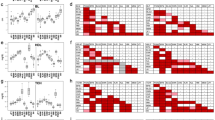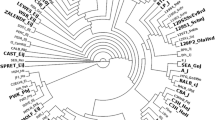Abstract
Dense genetic maps of mammalian genomes facilitate a variety of biological studies including the mapping of polygenic traits, positional cloning of monogenic traits, mapping of quantitative or qualitative trait loci, marker association, allelic imbalance, speed congenic construction, and evolutionary or phylogenetic comparison. In particular, single nucleotide polymorphisms (SNPs) have proved useful because of their abundance and compatibility with multiple high-throughput technology platforms. SNP genotyping is especially suited for the genetic analysis of model organisms such as the mouse because biallelic markers remain fully informative when used to characterize crosses between inbred strains. Here we report the mapping and genotyping of 673 SNPs (including 519 novel SNPs) in 55 of the most commonly used mouse strains. These data have allowed us to construct a phylogenetic tree that correlates and expands known genealogical relationships and clarifies the origin of strains previously having an uncertain ancestry. All 55 inbred strains are distinguishable genetically using this SNP panel. Our data reveal an uneven SNP distribution consistent with a mosaic pattern of inheritance and provide some insight into the changing dynamics of the physical architecture of the genome. Furthermore, these data represent a valuable resource for the selection of markers and the design of experiments that require the genetic distinction of any pair of mouse inbred strains such as the generation of congenic mice, positional cloning, and the mapping of quantitative or qualitative trait loci.


Similar content being viewed by others
References
Barton NH, Keightley PD (2002) Understanding quantitative genetic variation Nat Rev Genet 3: 11–21
Beck JA, Lloyd S, Hafezparast M, Lennon–Pierc e M, Eppig JT, et al. (2000) Genealogies of mouse inbred strains Nat Genet 24: 23–25
Copeland NG, Jenkins NA, Gilbert DJ, Eppig JT, Maltais LJ, et al. (1993) A genetic linkage map of the mouse: current applications and future prospects Science 262: 57–66
de Kok JB, Wiegerinck ET, Giesendorf BA, Swinkels DW (2002) Rapid genotyping of single nucleotide polymorphisms using novel minor groove binding DNA oligonucleotides (MGB probes) Hum Mutat 19: 554–559
Dietrick WF, Copeland NG, Gilbert DJ, Miller JC, Jenkins NA, et al. (1995) Mapping the mouse genome: current status and future prospects Proc Natl Acad Sci U S A 92: 10849–10853
Dietrich WF, Miller JA, Steen R, Merchant MA, Damron–Boles D, et al. (1996) A comprehensive genetic map of the mouse genome Nature 380: 149–152
Ferris SD, Sage RD, Prager EM, Ritte U, Wilson AC, (1983) Mitochondrial DNA evolution in mice Genetics 105: 681–721
Hartigan JA (1975) Clustering algorithms. New York: Wiley
Lindblad–Toh K, Winchester E, Daly MJ, Wang DG, Hirschhorn JN, et al. (2000) Large-scale discovery and genotyping of single-nucleotide polymorphisms in the mouse Nat Genet 24: 381–386
Moore KJ (1999) Utilization of mouse models in the discovery of human disease genes Drug Discov Today 4: 123–128
Petkov PM, Ding Y, Cassell MA, Zhang W, Wagner G, et al. (2004) An efficient SNP system for mouse genome scanning and elucidating strain relationships Genome Res. 14: 1806–1811
Sakai T, Kikkawa Y, Miura I, Inoue T, Moriwaki K, et al. (2005) Origins of mouse inbred strains deduced from whole-genome scanning by polymorphis microsatellite loci Mamm Genome 16: 11–19
Shen H, Suzuki T, Munroe DJ, Stewart C, Rasmussen L, et al. (2003) Common sites of retroviral integration in mouse hematopoietic tumors identified by high-throughput, single nucleotide polymorphism-based mapping and bacterial artificial chromosome hybridization J Virol. 77: 1584–1588
Talbot CJ, Nicod A, Cherny SS, Fulker DW, Collins Ac, et al. (1999) High-resolution mapping of quantitative trait loci in outbred mice Nat Genet 21: 305–308
Tsang S, Sun Z, Stewart C, Lum N, Frankenberger C, et al. (2004) Development of multiplex DNA electronic microarrays using a universal adaptor system for detection of single nucleotide polymorphisms Biotechniques 36: 682–688
Wade CM, Kulbokas EJ, Kirby AW, Zody MC, Mullikin JC, et al. (2002) The mosaic structure of variation in the laboratory mouse genome Nature 420: 574–578
Wakeland E, Morel L, Achey K, Yui M, Longmate J, (1997) Speed congenics: a classic technique in the fast lane (relatively speaking) Immunol Today 18: 472–477
Waterston RH, Lindblad–Toh K, Birney E, Rogers J, Abril JF, et al. (2002) Initial sequencing and comparative analysis of the mouse genome Nature 420: 520–562
Wiltshire T, Pletcher MT, Batalov S, Barnes SW, Tarantino LM, et al. (2003) Genome-wide single-nucleotide polymorphism analysis defines haplotype patterns in mouse Proc Natl Acad Sci USA. 100: 3380–3385
Wong GT (2002) Speed congenics: applications for transgenic and knock-out mouse strains Neuropeptides 36: 230–236
Acknowledgments
This project was funded in whole or in part with federal funds from the National Cancer Institute, National Institutes of Health, under Contract No. N01-C0-12400.
Author information
Authors and Affiliations
Corresponding author
Additional information
The content of this publication does not necessarily reflect the view or policies of the Department of Health and Human Services, nor does mention of trade names, commercial products, or organizations imply endorsement by the U.S. Government.
Rights and permissions
About this article
Cite this article
Tsang, S., Sun, Z., Luke, B. et al. A comprehensive SNP-based genetic analysis of inbred mouse strains. Mamm Genome 16, 476–480 (2005). https://doi.org/10.1007/s00335-005-0001-7
Received:
Accepted:
Issue Date:
DOI: https://doi.org/10.1007/s00335-005-0001-7




